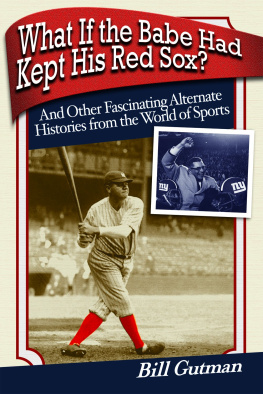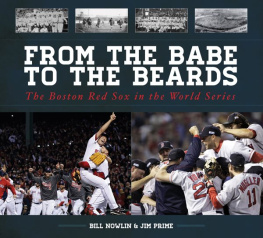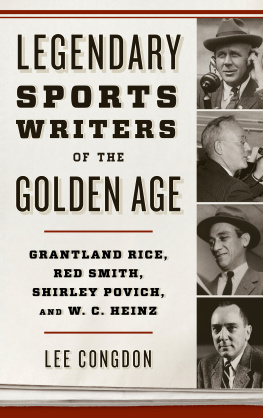BILL GUTMAN is a longtime freelance writer who has written about all the major sports for more than three decades. Over the years he has published numerous sports histories, as well as biographies of Pistol Pete Maravich, Magic Johnson, Lance Armstrong, and Bill Parcells. Some of his recent books include Won for All: The Inside Story of the New England Patriots Impossible Run to the Super Bowl (with Pepper Johnson), Twice Around the Bases: A Thinking Fans Inside Look at Baseball (with Kevin Kennedy), and Heroes of Football: The Story of Americas Game (with John Madden). Mr. Gutman lives in upstate New York with his wife, Cathy.
The Boston Babe
On December 26, 1919, the New York Yankees received a belated Christmas gift. They completed a deal that would bring Boston Red Sox pitcher/outfielder George Herman Babe Ruth to New York. The Yanks had purchased the young slugging sensation for the then unheard-of price of $125,000, more than double the highest price ever paid for a ballplayer. The deal between the New Yorkers and Boston owner Harry Frazee wasnt all that simple. There were more reasons for it than people think, but the bottom line was that it brought the Babe to New York, where he would proceed to turn the baseball and sporting world on its ear, and begin in earnest a record-setting career that also launched a Yankee dynasty which seemed to never die. It also left the floundering Red Sox with collateral damage that would come to be called The Curse of the Bambino, and which wouldnt end until the Sox finally won the World Series in 2004. Babe Ruth is still mentioned with great reverence today and continues to be, in some ways, the face of the Yankees.
But what if the Babe had kept his Red Sox?
In a sense, Babe Ruth was an unlikely hero, an unlikely superstar, and most unlikelyat least at the beginningto become arguably the greatest baseball player of all time. He came from proverbial humble beginnings, and by the time he was seven years old, his parents could no longer handle him. So they sent him to the St. Marys Industrial School for Boys, which was, in essence, a reform school run by Catholic brothers in Baltimore. This happened back in 1902 when not only the Babe but baseball itself was in its early days. It would have taken one helluva soothsayer to predict that this out-of-control youngster would grow into a national hero and, in the eyes of some, the man who saved baseball.
By now the story is well known to real baseball fans. At St. Marys, Babe came under the tutelage of Brother Matthias, the schools disciplinarian, who took a liking to the incorrigible kid and subsequently introduced him to baseball. Before long it was apparent that young George Ruth was a natural, and by 1914 Jack Dunn, who owned the minor league Baltimore Orioles, had signed the nineteen-year-old to a contract with plans to use him as a left-handed pitcher. Dunn also became the teens legal guardian. Legend has it that on the first day of spring training, as Dunn took his rookie out to the mound, someone yelled: Hey, look at Dunnie and his new babe.
And so a nickname for the ages was born, followed soon after by a very talented ballplayer. By early July, the young Babe had a 14-6 record, but the Orioles were losing money fast and on July 8, Dunn sold the Babe, along with pitcher Ernie Shore and catcher Ben Egan, to the Boston Red Sox for $8,500. Ruth signed a two-and-a-half year contract valued at $3,500 a season to pitch for Boston. Three days later he beat Cleveland 4-3 for his first big league win. He would finish the year in the minors, but beginning in 1915 the Babe quickly established himself as the best young left-handed pitcher in the majors, compiling records of 18-8, 23-12, and 24-13 over the next three seasons. And in those latter two campaigns, 1916 and 1917, he finished with earned run averages of 1.75 and 2.01, respectively. Thats how good he was.
But the big guyand at 62, 190 pounds, he was big for a ballplayer in those dayscould also do something else very well. He could hit better than any other pitcher in the league and better than many of his teammates. On May 6, 1915, the Babe blasted his first big league home run against the Yankees at the old Polo Grounds. He would hit four that season, which is nothing to brag about today, but in the dead-ball era, that was good enough to lead the Red Sox. And it didnt hurt that his team also won the pennant.
Led by a very strong pitching staff, Boston would take three pennants over four years, winning the World Series in both 1916 and 1918. The Babe was 3-0 in the pair of Fall Classics, setting a record along the way by throwing 29 straight scoreless innings, and having a combined 0.87 earned run average. By 1918, the Sox realized they had something special in the big guy, something other than his valuable left arm. His pitching record was just 13-7 because he was now spending more time in the outfield. The team wanted his potent bat in the lineup. He played enough to get 317 at bats and lead the American League with 11 home runs while hitting an even .300. Not counting his mound appearances, he played 59 games in the outfield and another 13 at first base. With the Sox dominating the American League and Ruth emerging as a huge star, the question in 1919 was how much he would pitch and how much he would play the outfield.
THE WORLD OF HARRY FRAZEE
Harry Frazee owned the Boston Red Sox from November 1916 to July 1923. That isnt a long time in baseball years, but fans in Bean-town even today know his name and continue to rank him as the biggest villain in Red Sox history. Why? Its easy. Hes the guy who sold Babe Ruth to the Yankees and brought upon the Red Sox the infamous Curse of the Bambino, which would haunt the Sox from 1920 to 2004. Many people think that Frazee sold the Babe to the Yanks to finance the Broadway show No, No, Nanette . But it was-nt quite as simple as that.
The Illinois-born Frazee always had a penchant for show business, and in those days that meant Broadway. By 1907 he had built his first theatre in Chicago and then, in 1913, he opened the Long-acre Theatre on Broadway in New York. He also acquired a theatre in Boston and subsequently produced a string of hit shows. When his latest offering, Nothing but the Truth, was a success on Broadway in late 1916, Frazee decided to do something else with the profits. He bought the Red Sox on November 1, from Joseph Lannin, for the sum of $675,000. As it turns out, he didnt pay in full. He gave Lannin some of the cash and the rest in the form of notes. But he owned the team and one of the stars he inherited was a young left-handed pitcher, Babe Ruth.
I have always enjoyed the game, Frazee said after the purchase. Now I think I shall have a chance to show what I know about handling a baseball club. I think that by giving the public a first-class article, I am bound to hold their support. And this goes double for Boston, by all odds the greatest ball town on earth.








